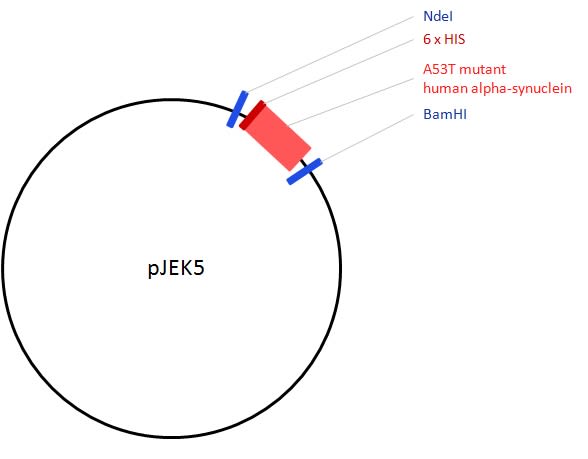pJEK5 Alpha-Synuclein A53T Vector
Invented by Dr Fiona Benson from Lancaster University
Invented at Lancaster University
- Datasheet
- References (0)
- Inventor Info
Info
| Catalogue Number | 152048 |
| Relevance |
Alpha synuclein is expressed predominantly in the brain, where it is concentrated in presynaptic nerve terminals. The deposition of the abundant presynaptic brain protein alpha-synuclein as fibrillary aggregates in neurons or glial cells is a hallmark lesion in a subset of neurodegenerative disorders. These disorders include Parkinson's disease (PD), dementia with Lewy bodies (DLB) and multiple system atrophy, collectively referred to as synucleinopathies. Parkinson's disease (PD) is a common neurodegenerative disorder characterized by the progressive accumulation in selected neurons of protein inclusions containing alpha-synuclein and ubiquitin. A point mutation in the α-synuclein gene, A53T (Ala53-Thr), is linked to familial Parkinson′s disease. Mice expressing A53T human α-synuclein, but not wild-type or the A30P variants, develop adult-onset neurodegenerative disease with a progressive motoric dysfunction leading to death |
| Research Area | Neurobiology |
| Notes | pJEK5 ("A53T") is a derivative of pET15b with the open reading frame encoding the A53T mutant human α-synuclein cloned in via the NdeI and BamHI restriction sites. It was constructed via site-specific mutagenesis of pJEK1, replacing the G at position 88 in the ORF nucleotide sequence with a C, thus altering the 30th codon from GCA encoding Ala, to CCA encoding Pro. In this construct A30P alpha-synuclein is expressed as a fusion protein with an N-terminal six His tag. |
References
There are 0 reference entries for this reagent.
References: 0 entry
There is no reference for this reagent yet, feel free to use the button below to suggest one.
Add a reference
References: 0 entry
There is no reference for this reagent yet, feel free to use the button below to suggest one.
Add a reference






